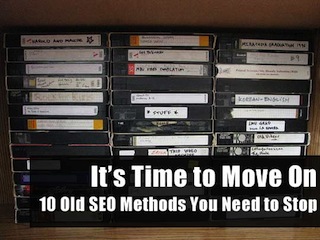 I’m proud to say that I’ve never been responsible for a site that has been punished by any of the Google Panda/Penguin updates.
I’m proud to say that I’ve never been responsible for a site that has been punished by any of the Google Panda/Penguin updates.
I’ve seen my fair share of Google fallout though, usually brought forth by someone after they’ve seen their traffic tank. They don’t know what happened, why, or much less how to fix it.
Truth be told, I’m surprised by how often I’ve been presented with this scenario. Every single time it’s boiled down to using bad SEO or outdated SEO tactics that they consider tried and true but are no longer valid.
As Mark Jackson stated in “7 Habits of Highly Effective SEO“:
While we must be aware, and understand, things like Google Panda/Penguin and other major changes in the algorithms, if we focus on doing “good marketing”, all other things should fall in line, and major algorithm changes shouldn’t be a concern.
And that’s the crux of the issue:

Here are 10 old SEO methods that I’ve seen come across my desk in the past two weeks and how you can do better.
1. Article Submissions
If the word “EzineArticles” falls out of your mouth when you start talking about your SEO, you should just stop right there. Even before the Panda update, this really wasn’t the best use of your time and essentially was just a way to get some quick links back to your site.
Get this through your head: link building isn’t easy. It, like all things in optimization, takes time and effort.
Instead of going after easy links, why not work on building relationships with bloggers and work on writing guest posts that can add value to their site and community while benefitting you with exposure to their audience and possibly building a quality reference from an authoritative site.
Here are some tips: 8 Steps to Guest Blogging Artistry for Free Links, Recognition & Exposure
2. Press Releases Without News
From a conversation I had last week:
“Well if free article submissions aren’t good, maybe I could do a press release instead?”
— “Do you have anything newsworthy?”
“Well, I don’t know but I need to get my name out and it would be a great chance to get some links from the news channels. I was thinking maybe doing 2 a month.”
— “No. Just.. No.”

Here’s the thing, you run a business, and kudos to you. According to Dun and Bradstreet there are an estimated 23 million small businesses in the United States as of 2010. I’m not saying that you’re not doing something that’s newsworthy, but just existing doesn’t qualify you.
Ask any public relations agency and they’ll be quick to tell you that there’s more to PR than just a press release. Kimberly Eberl, President of Motion PR in Chicago states:
Public relations is a conversation between a company and all of its different stakeholders. It encourages company transparency and works to the benefit of all parties. PR is about building awareness and leveraging relationships through various channels and markets.
Kinda sounds like link building, doesn’t it? Press releases for the sake of links alone is probably just as close to a waste of time as article submissions.
Remember, no quick fixes. Do something newsworthy and good. You’ll be helping someone else at that, in turn can help you with effective media relations and the links will follow.
3. Reciprical Linking & Link Exchanges
What is this, 2004? Link exchanges are just another way to try to take the work out of gaining links and earning trust by swapping links with another site.
Can you think of a more easily detectible signal that you could throw at a search engine to let them know you’re trying to get cheap, useless links?
Think of a link as an endorsement of sorts. A link should mostly be used when it makes sense and can help the visitor by pointing them to additional resources or related material.
If someone makes good content then that will help your readers or site visitors, then by all means link to them. That works the other way around too: *hint* *hint*
4. Creating Thin Content
This bad SEO technique just doesn’t want to die. I get it, old habits die hard. But friends, it’s time to move on.
We already know that great content can drive great links. Here are a few questions to ask yourself when looking at your content creation:
- Are you outsourcing your content writing? If so, who is doing your writing? Is it the person most qualified to build out superb, link worthy content?
- Who are you writing for and why? Are you writing for search engines or are you writing to build an audience? These shouldn’t be mutually exclusive things, by the way.
- Do you feel like you’re writing the same thing over and over and over again and you’re so tired of it because there are only so many ways you can write about whatever it is that you sell? You’re likely doing it wrong. Sorry, but it’s the truth. Writing can indeed be tedious but think of the question above. If you can’t stand what your writing, what are the chances that others are going to think it’s great? Will they think it’s great enough to link to?
5. Losing Your Voice Through Automation
I’m not going to dive face first into the automated tools debate that constantly seems to circulate through the social media sphere. A tool to help streamline, disseminate content, and balance time can be just that, a tool.
Tools all have their purpose and can all be useful given the right circumstances. That said, you don’t saw a board with a hammer. Learn your tools. Use them, but use them wisely.
Social media, including your blog, is a way for you to build relationships. It can help you gain and keep customers or open new doors for the future.
Automation is often seen as an easy way out for companies that know they’re supposed to “be social” but they don’t want to be, they just know it’s “important” for some reason.
You’re not fooling anyone. Social media gives you a voice. Trying to take the easy way out is like putting your company on mute.
6. Ignoring Social Signals
Thankfully most blogs and websites nowadays have social sharing buttons of some sort. Unfortunately, many site owners aren’t paying attention to these social signals, what they mean, or their potential.
Let’s turn to Google’s CEO, Larry Page, to help me tell you to stop ignoring this:
In a recent Google earnings call, he was asked, “If you think of the future of Internet search three or four years out, how important will the social signal be and how important (will) personalization be?”
He responded by explaining how he might search for one of his friends who had a common name.
“For the first time, the search box isn’t really searching a string…it’s actually searching for that person that I know. Having real feedback from users…is very useful for search…we have a lot of those signals already, but we can always use more…we can always use better relevance and we can always use more data to generate that.”
7. Implementing Tactics without a Strategy
Truth be told #1-6 above all fit into this but I felt like this should have its own little mention. Why? Because this is a pattern by which a lot of people set out into SEO and it’s why old SEO methods are still being used. It’s also why so many people fail at marketing in general.
I can’t stress this enough: plan out a strategy and work the plan! Test all the time. Rinse. Repeat.
8. Focus on Rankings
I was handed a ranking report by an SEO the other day which they had run for their client of five years. It was 30 pages long and tracked hundreds of keyphrases.
I asked how this correlated to their analytics and how the traffic behaved since the client had felt that their sales were down. The SEO looked at me and said, “Umm. I don’t know if they have analytics on their site. Maybe I looked at it once… I’m not sure. But I’ve run ranking reports for them every month and they like that.”
Wow.

I know how alluring those ranking reports can be. I know you do work, and this is a nice little report that you can show your client or your boss that says “We’re number 1 in Google for ‘Blue Spandex Widgets For Sales in Wichita, KS’!!”
However it’s our job as an SEO to steer the conversation from the old way into a more meaningful one. If we don’t, we’re taking the path of least resistance and we truly aren’t helping ourselves or our clients.
9. Focusing on Google Only
You may have a problem that you’re not aware of yet because maybe everything is going along swimmingly. Go look at your stats, right now. How much of your organic traffic comes from Google? What percentage?
I know you wouldn’t put all of your retirement plan in one stock so why would you put so much at risk in your current life by keeping all your eggs in one basket. Create a diverse traffic portfolio.
Although geared towards the travel industry, I believe everyone who is thinking about this could benefit from reading: Getting Serious about Inbound Marketing
10. Ignoring Design
I have one last bone to pick with something that a lot of people don’t think of when it comes to SEO, but it fits and I’m tired of running into it. You know that website that you have? Oh, you helped design it? Yes, I see how that menu looks all cool. Flash, you don’t say?
Your website can say a lot about you and your brand. I know a lot of people pay a lot of good money for a site, only to have it be ugly as sin, non-functional, or not search engine friendly. This has been going on since I started working online and it’s not bound to stop anytime soon but I’m pleading with you to save yourself the time and money and headache:
The next time you go to build a site, hire a designer. Shop around. But when you find one that’s good, trust in them and their design work. They do this for a living and you don’t.
Guide your designer, but don’t do the designing. You didn’t hire them to just use tools you don’t understand. Allow them the freedom to make something great for you.
At the same time, you should also hire a great SEO. This person will work with the designer and the developer to ensure that what you end up with not only works to your needs but will do everything it needs to do in regards to the search engines as well.
Don’t settle for or ignore your website design. Your customers aren’t.
Original Image Credit: VHS Survivors by Homies In Heaven/Flickr.
Editor’s note: This column originally was published on August 7, 2012, and comes in at No. 8 on our countdown of the 10 most popular Search Engine Watch columns of 2012. As the clock ticks down to 2013, we’re celebrating the Best of 2012 by revisiting our most popular columns, as determined by our readers. Enjoy and keep checking back!
 I’m proud to say that I’ve never been responsible for a site that has been punished by any of the Google Panda/Penguin updates.
I’m proud to say that I’ve never been responsible for a site that has been punished by any of the Google Panda/Penguin updates.

